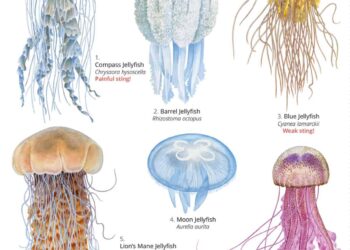The Museum of Southwestern Biology at the University of New Mexico recently opened its doors to the public for an exclusive behind-the-scenes experience, spotlighted in the new feature “It’s (Probably) Not Rocket Science.” This initiative offers a rare glimpse into the museum’s extensive collections and groundbreaking research, highlighting the critical role of biodiversity studies in understanding our natural world. As scientists and educators work to make complex biological concepts accessible, the Museum of Southwestern Biology continues to serve as a vital resource for both the academic community and the general public.
Exploring the Unique Collections that Define the Museum of Southwestern Biology
The Museum of Southwestern Biology boasts a collection that spans millions of years and showcases the incredible biodiversity of the Southwestern United States and beyond. From meticulously preserved specimens of mammals, birds, amphibians, and reptiles to vast archives of genetic material, this museum plays a crucial role in scientific research and conservation efforts. Visitors often marvel at the depth and breadth of the exhibits, which not only highlight rare and endangered species but also provide insight into ecological relationships and evolutionary history.
Among the museum’s standout offerings are the type specimens-the original examples used for the formal description of species-and an extensive repository of frozen tissue samples vital for genomics studies. The collection’s ongoing expansion is supported by collaborations with field researchers, universities, and conservation organizations. Below is a snapshot of key collection highlights:
- Vertebrate Specimens: Over 200,000 cataloged samples including mammals, birds, and reptiles.
- Genetic Resources: Tens of thousands of frozen tissue samples used for DNA analysis.
- Fossil Record: Fossils dating back to the Pleistocene providing historical context.
- Environmental Archives: Data sets that track species distribution and environmental changes.
| Collection Type | Number of Specimens | Significance |
|---|---|---|
| Mammals | 85,000+ | Supports behavioral and ecological research |
| Birds | 60,000+ | Helps map migratory patterns |
| Amphibians & Reptiles | 45,000+ | Critical for conservation studies |
| Frozen Tissue Samples | 30,000+ | Enables genetic and evolutionary investigations |
Behind the Scenes Insights into Specimen Preservation and Research Techniques
At the heart of the Museum of Southwestern Biology lies a meticulously organized world, where preservation techniques ensure the longevity and scientific value of countless specimens. Staff employ a range of sophisticated methods-from cryogenic storage that halts biological processes to controlled atmosphere chambers that prevent decay. These preservation strategies are vital, allowing researchers to examine specimens years or even decades after collection without compromising integrity.
Behind the scenes, the research process is equally rigorous. Curators and scientists collaborate closely to catalog and analyze specimens using cutting-edge technology. Key practices include:
- Digitizing specimen records for seamless data sharing.
- Applying molecular techniques to unlock genetic secrets.
- Maintaining detailed environmental metadata to support ecological studies.
| Preservation Method | Purpose | Example Specimens |
|---|---|---|
| Freeze-Drying | Removes moisture to prevent decay | Fossils, insect samples |
| Alcohol Storage | Preserves soft tissue | Amphibians, fish |
| Paraffin Embedding | Prepares tissue for microscopic study | Small mammals, organs |
Recommendations for Engaging with the Museum’s Educational Programs and Exhibits
Visitors are encouraged to dive deeply into the rich scientific narratives presented throughout the Museum of Southwestern Biology by taking full advantage of the hands-on activities and interactive displays. Active participation enhances understanding, whether it’s through detailed specimen examination, attending curator-led talks, or joining workshop sessions aimed at different age groups. To maximize the educational experience, consider scheduling visits during special program days when expert researchers are available to share insights and answer questions in real time.
For educators and group leaders, pre-visit preparation can significantly enhance engagement. Utilize the Museum’s online resources to familiarize yourself with current exhibits and available materials. When exploring on-site, encourage students or visitors to:
- Ask open-ended questions to stimulate critical thinking
- Document observations through sketching or journaling
- Collaborate with peers to discuss scientific concepts in a social setting
Below is a quick reference guide to tailor visit experiences:
| Visitor Type | Recommended Activity | Ideal Duration | |
|---|---|---|---|
| Families with Children | Interactive specimen handling & scavenger hunts | 1.5-2 hours | |
| University Students | Lectures, research discussions, behind-the-scenes tours | 2-3 hours | |
| Visitor Type |
Recommended Activity |
Ideal Duration |
|
| Families with Children | Interactive specimen handling & scavenger hunts | 1.5-2 hours | |
| University Students | Lectures, research discussions, behind-the-scenes tours | 2-3 hours | |
| Educators & Group Leaders | Pre-visit workshops, guided tours, tailored group activities | 2 hours | |
| General Visitors | Self-guided tours, interactive displays, curator talks | 1-1.5 hours |
If you would like me to help with anything else – for example, formatting, additional visitor tips, or content suggestions – just let me know!
The Conclusion
As visitors step through the doors of the Museum of Southwestern Biology, “It’s (Probably) Not Rocket Science” offers a unique glimpse into the fascinating world of biological research and conservation. By demystifying the scientific process and highlighting the museum’s invaluable collections, the exhibit underscores the vital role that biology plays in understanding and preserving our natural world. For those eager to explore the complexities of life on Earth through accessible and engaging displays, the Museum of Southwestern Biology continues to serve as an essential resource and educational hub at the University of New Mexico.






























